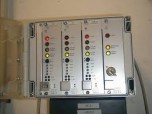Gas Detection System
About Gas Detection System

Gas Detection System :
Gas Detection System : The most common method employed to continuously monitor for leakage of hazardous gases is to place a number of sensors at the places where any leaks are most likely to occur. These are often then connected electrically to a multi-channel controller located some distance away in a safe, gas free area with display and alarm facilities, event recording devices etc. This is often referred to as a fixed point system. As its name implies, it is permanently located in the area (e.g. an offshore platform, oil refinery, laboratory cold storage etc).
The complexity of any gas detection system depends on the use to which the data will be put. Data recording allows the information to be used to identify problem areas and assist in the implementation of safety measures. If the system is to be used for warnings only, then the outputs from the system can be simple and no data storage is necessary. In choosing a system, therefore, it is important to know how the information will be used so that the proper system components can be chosen. In toxic gas monitoring, the use of multi-point systems has rapidly demonstrated their potential for solving a wide variety of workplace exposure problems and is invaluable for both identifying problems and for keeping workers and management aware of pollutant concentrations in the workplace.
In the design of multi-point systems, considerable thought should be given to the various components and to their interconnection. When using catalytic detection sensors, for instance, the electrical cable connections to the sensors would have three cores, each of 1mm squared, carrying not only the output signal, but also power to the electrical bridge circuit, which is located at the sensor to reduce signal voltage drop along the cables.
Contact For More Technical Details: contact@oilandgasproducts.com




































